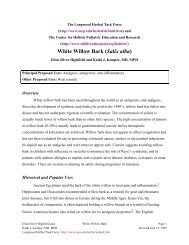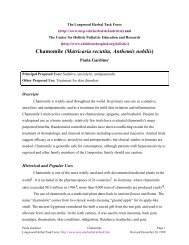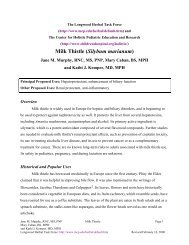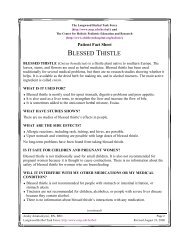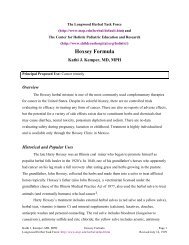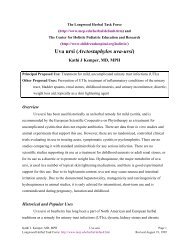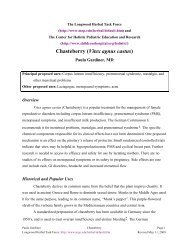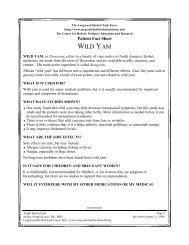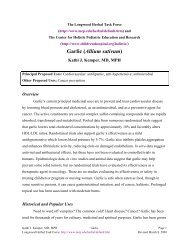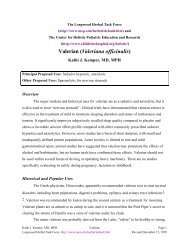Dandelion (Taraxacum officinalis) - Longwood Herbal Task Force
Dandelion (Taraxacum officinalis) - Longwood Herbal Task Force
Dandelion (Taraxacum officinalis) - Longwood Herbal Task Force
You also want an ePaper? Increase the reach of your titles
YUMPU automatically turns print PDFs into web optimized ePapers that Google loves.
and pneumonia, and as a topical compress to treat mastitis. As recently as 1957, more than 20<br />
tons of dandelion leaves were imported into the US annually for medicinal purposes 2 .<br />
<strong>Dandelion</strong> was included as a diuretic in the US pharmacopeia from 1831 to 1926 3 . Based<br />
on its diuretic effects, dandelion is often included in herbal weight loss and premenstrual<br />
syndrome remedies. Some herbalists also recommend it as a way to help prevent<br />
atherosclerosis 4 . Others suggest it may be a useful spring and fall tonic for patients with chronic<br />
osteoarthritis and those with a tendency to form gallstones 5 .<br />
In addition to its medicinal uses, dandelion serves as a salad green in the gourmet’s<br />
garden and as an unwelcome weed in the well-manicured lawn. The leaves are an excellent<br />
source of vitamin A. The ground roots are sometimes used as a substitute for chicory roots or<br />
coffee beans. The flowers are sometimes fermented into wine. The root is the part most often<br />
used medicinally 2 . The German Commission E approves it for use as a diuretic and to treat<br />
dyspepsia, liver and gallbladder complaints and appetite loss 6, 7 .<br />
Botany<br />
Medicinal species: <strong>Taraxacum</strong> <strong>officinalis</strong> aka Leontodon taraxacum (roots are Radix taraxaci;<br />
leaves are Herba taraxaci). Europeans have developed over 100 specialized varieties for<br />
salads, cooking, wine, and as a coffee substitute.<br />
Common names: Blowball, canker wart, fairy clock, lion’s tooth, piss-in-bed, white endive, wild<br />
endive; Lowenzahnwurzel (Ger); pissenlit (Fr); pu gong ying (Ch) 3, 8<br />
Botanical family: Compositae, sub-family Cichoroideae (chicory)<br />
Plant description: <strong>Dandelion</strong> is known as a self-sowing, variable perennial – also known as a<br />
weed. The dentate leaves grow close to the ground in a rosette around the hollow stem.<br />
The tap root extends several inches into the ground. The yellow flowers are sensitive to<br />
light, opening in bright sunlight and closing during dark and dreary days; they bloom<br />
throughout the summer and becomes “fuzzball”, full of feathery seeds.<br />
Where it’s grown: <strong>Dandelion</strong> was originally native to Europe and Asia, but made a successful<br />
transition across the Atlantic ocean; it now grows amazingly well in yards, gardens,<br />
fields, roadsides, open meadows and waste ground.<br />
Kathi J. Kemper, MD, MPH <strong>Dandelion</strong> Page 2<br />
<strong>Longwood</strong> <strong>Herbal</strong> <strong>Task</strong> <strong>Force</strong>: http://www.mcp.edu/herbal/default.htm Revised November 1, 1999



